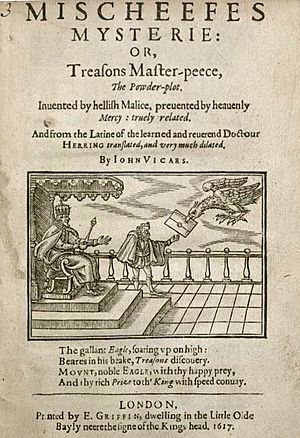Francis Herring facts for kids
Francis Herring was an English doctor and writer who lived a long time ago, in the 1600s. He was known for his medical writings and also for his religious poems.
Life of Francis Herring
Francis Herring was born in a place called Nottinghamshire, England. He went to Christ's College, Cambridge University. He earned his first degree in 1585 and a master's degree in 1589.
In 1599, after becoming a doctor of medicine, he joined the College of Physicians in London. This was a very important group of doctors. He held several important roles there, like being a "censor" many times between 1609 and 1627. A censor was like a supervisor who made sure doctors followed the rules. He passed away in early 1628.
Francis Herring's Writings
Francis Herring wrote and translated several books. He wanted to share his knowledge about medicine and also his thoughts on important events of his time.
- The Anatomyes of the True Physition and Counterfeit Mounte-banke (1602): This book was a translation from Latin. It described what a real doctor should be like, compared to a "mountebank." A mountebank was someone who pretended to be a doctor but was actually a fake, often selling useless medicines. Herring also added a section about how fake doctors in London tricked people into spending their money.
- Certaine Rules, Directions or Advertisements for this time of Pestilentiall Contagion (1603, revised 1625): This book gave advice on how to deal with the bubonic plague, a very dangerous disease that was common back then. He also warned people not to wear "impoisoned amulets" around their necks. These were charms that some people believed would protect them from the plague, but Herring thought they were harmful. An updated version of this book was published in 1665, called Preservatives against the Plague.
- A modest Defence of the Caveat given to the wearers of impoisoned Amulets (1604): After his first book, another doctor named Peter Turner disagreed with Herring about the amulets. Turner believed some amulets, even those with arsenic (a poison), could help against the plague. Herring wrote this book to defend his earlier warning and to explain why he believed the plague was indeed infectious.
- Pietas Pontificia (1606): This was a long poem written in Latin. It was about the famous Gunpowder Plot of 1605. This was a plan by a group of people to blow up the Houses of Parliament and King James I. Herring's poem also talked about "popery," which was a term used at the time to describe the beliefs of the Catholic Church, especially during a period of religious tension in England. An English translation of this poem was published in 1610.
- Pietas Pontificia … ab authore recognita (1609): This was an updated version of his poem about the Gunpowder Plot. It included more parts, like an "Epigram against Jesuites," which was a short, witty poem against the Jesuits, a religious order.
Later, both parts of Herring's poem about the Gunpowder Plot were translated into English by John Vicars. This English version was called Mischeefes Mysterie and was published in 1617. Another edition came out in 1641 with the title The Quintessence of Cruelty.


